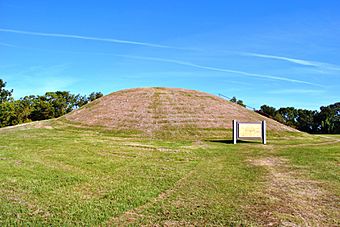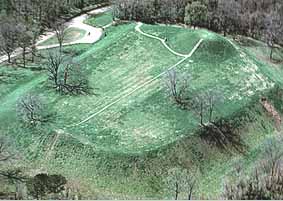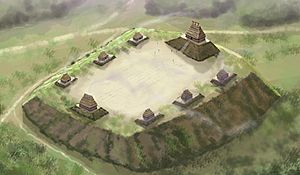Emerald Mound Site facts for kids
|
Emerald Mound Site
|
|

Secondary mound at west end of Emerald Mound
|
|
| Nearest city | Stanton, Mississippi |
|---|---|
| NRHP reference No. | 88002618 |
Quick facts for kids Significant dates |
|
| Added to NRHP | November 18, 1988 |
| Designated NHL | December 29, 1989 |
The Emerald Mound Site is an ancient place in Mississippi, United States. It is also known as the Selsertown site. This special spot is located on the Natchez Trace Parkway near Stanton.
The mound was built by people of the Plaquemine culture during the Mississippian period. It was used between 1200 and 1730 CE. Later, the Natchez people used it as a main place for their ceremonies.
Emerald Mound is a huge platform mound. It is the second-largest earthwork built by Mississippian people in the entire country. Only Monk's Mound at Cahokia, Illinois, is bigger.
The mound covers about eight acres of land. It is 770 feet (235 meters) long and 435 feet (133 meters) wide at its base. It stands 35 feet (11 meters) tall. Emerald Mound has a flat top with two smaller mounds on each end. It was built around a natural hill.
Long ago, there were six other smaller mounds around it. There was also a ditch that circled the whole area. These features are no longer there today. The National Park Service helped protect the mound in 1955. It became a National Historic Landmark in 1989. You can visit Emerald Mound today.
Building Emerald Mound: A Look Back in Time
Emerald Mound was built between 1250 and 1600 CE. It was a very important place for the Plaquemine culture. People who lived in nearby villages used it as a center for their ceremonies. The mound gets its name from a plantation that was once in the area.
The main mound started as a natural hill. Workers added earth to its sides, shaping it into a large, flat, artificial plateau. This plateau is like a giant, flat-topped hill. Two smaller mounds sit on top of this main plateau, one at each end.
The larger of these two smaller mounds is at the western end. It is 190 feet (58 meters) long and 160 feet (49 meters) wide at its base. It stands 30 feet (9 meters) tall. These smaller mounds on top were likely platforms for the homes of chiefs or other important leaders.
The top of the main mound is about 65 feet (20 meters) higher than the land around it. Old drawings show that six other small mounds once lined the sides of the main mound. These were flattened over time by farming and weather. An old ditch also once circled the entire mound complex.
Who Used Emerald Mound?
Archaeologists study old sites like Emerald Mound. They believe the people who built it were ancestors of the Natchez people. The Natchez lived in this area when Europeans first arrived. They used Emerald Mound as their main ceremonial center.
At its busiest, Emerald Mound was a hub for religious and community events. The main ceremonial area was on top of the mound. This was unusual for mound centers. The smaller mounds on top were likely bases for a temple and homes for important leaders.
By the late 1730s, the Natchez had left Emerald Mound. This might have happened because many people died from European diseases. These diseases were brought to the area by explorers like Hernando de Soto in the 1540s.
By 1682, the Natchez's main ceremonial center had moved. It was then at the Grand Village of the Natchez, about 12 miles (19 km) away. Emerald Mound was no longer used after the French arrived in the area. The Natchez people lived in small family farms and villages. They would gather at ceremonial centers for special events. Emerald Mound was one of the last large platform mounds built along the Mississippi River.
Exploring the Past: Digging at Emerald Mound
The site was first known as the Selsertown site. It later got its current name from the Emerald Plantation nearby. The first digs happened in 1838. A man named John C. Van Tramp wrote about them in his book.
During these early digs, people measured the mound. They also found pottery and skeletons. They noted the eight smaller mounds and the large ditch. More digs have happened over the years, with the most recent in 1972.
National Park Service archaeologists have studied what they found. They looked at animal bones, pieces of pottery, and tools. They also studied the layers of earth, called stratigraphy. This helps them learn about the daily lives of the ancient people who lived at Emerald Mound.
The owners gave the site to the National Park Service in the 1950s. Some of the smaller mounds were getting damaged by erosion. So, the Park Service fixed them and planted grass on their surfaces. They also built a path and stairs for visitors. These stairs led from the parking lot to the top of the main mound and the larger secondary mound. The staircases have since been removed.





